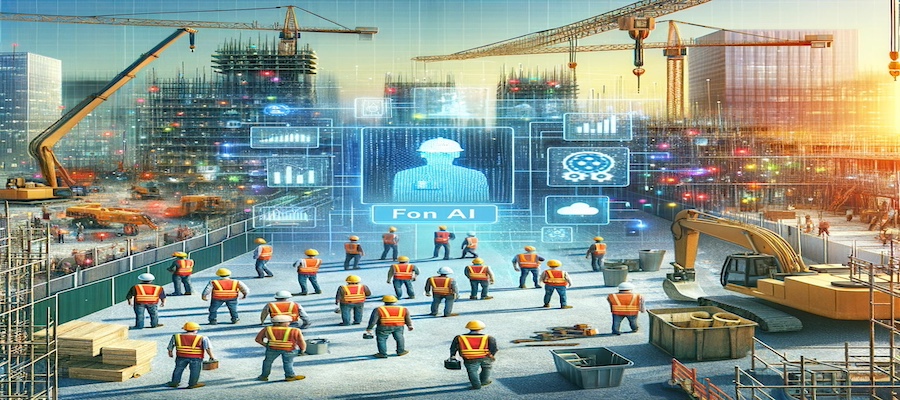AI-Enhanced Safety: Preventing Falls at Construction Sites

The construction industry, known for its contribution to shaping the skylines and infrastructures of our cities, also faces a significant challenge: ensuring the safety of its workers. Among the various hazards present at construction sites, falls from heights remain one of the most prevalent causes of fatal injuries. This stark reality brings to the forefront the need for innovative solutions to enhance safety measures and protect workers from such risks.
As we delve into this critical topic, we uncover how the advent of artificial intelligence (AI) and video analytics is providing groundbreaking methods to predict, monitor, and prevent falls at construction sites. This integration of technology is not just a leap in safety protocols but also a testament to the industry's commitment to embracing modern solutions for age-old problems.
The Rise of AI in Construction Safety
The integration of Artificial Intelligence (AI) in construction has opened new avenues for enhancing worksite safety. With the rise of smart technology, AI video analytics have become a pivotal tool in the construction industry’s arsenal against safety hazards, particularly in preventing falls from heights.
AI Video Analytics: A Game-Changer in Construction
AI video analytics leverage advanced algorithms to analyze video footage from construction sites in real-time. This technology goes beyond traditional surveillance by not just recording but actively interpreting visual data to identify potential safety breaches. By detecting unusual movements, identifying workers without proper safety gear, and alerting supervisors to hazardous situations, AI acts as a vigilant protector against the risks associated with construction work.
Growing Importance in the Industry
The growing emphasis on workplace safety regulations and the increasing complexity of construction projects have made AI video analytics an indispensable tool. It's not just about compliance; it's about creating a proactive safety culture. Construction firms are increasingly adopting this technology to ensure the well-being of their workforce, minimize the risk of accidents, and maintain high safety standards.
How AI Video Analytics Help in Preventing Falls
Harnessing AI for Enhanced Safety Monitoring
At the core of AI video analytics is its ability to continuously monitor construction sites for safety hazards. This technology utilizes advanced machine learning algorithms to analyze video feeds, enabling it to recognize patterns and detect anomalies that may signal a risk of falls. By processing vast amounts of visual data, AI systems can identify situations that might be overlooked by the human eye, such as a worker nearing an unprotected edge or operating at unsafe heights.
Key Features and Functionalities
- Real-Time Alerting: One of the most significant benefits of AI video analytics is its ability to provide real-time alerts. When the system detects a potential fall hazard, it immediately notifies site supervisors or safety personnel, allowing for swift intervention to prevent accidents.
- Proximity Detection: AI systems are adept at estimating the distance between workers and potential hazards. By ensuring that workers maintain safe distances from high-risk areas, the technology plays a crucial role in fall prevention.
- PPE Compliance Monitoring: Ensuring that workers wear proper personal protective equipment (PPE) is crucial. AI video analytics can detect whether workers are equipped with the necessary safety gear, such as harnesses and helmets, especially when working at heights.
- Behavior Analysis: Beyond mere detection, AI algorithms can analyze worker behavior patterns to identify risky behaviors or practices that could lead to falls, facilitating proactive safety training and policy adjustments.
Case Studies and Real-World Applications
The effectiveness of AI video analytics in enhancing construction site safety is best illustrated through real-world applications and case studies. These examples not only showcase the technology's capabilities but also highlight its practical impact in preventing falls and ensuring worker safety.
- Skanska's Use of 360-Degree Cameras and AI Software: Skanska utilized 360-degree cameras and AI software Smartvid to detect safety hazards such as missing guard rails and workers without PPE.
- Suffolk's AI-Based Safety Analysis: Suffolk developed an algorithm to analyze site photos for safety hazards, aiming to increase productivity significantly.
- Innovate UK's Real-Time Video Analysis Trials: Trials of real-time video analysis powered by machine learning algorithms were conducted at work site entrances and exits.
- Pillar Technologies' Sensor-Based Monitoring: Pillar Technologies used sensor-equipped devices to monitor environmental factors at construction sites for safety and predictive analysis.
Challenges and Limitations
While AI video analytics offer remarkable benefits in enhancing construction safety, there are challenges and limitations to its implementation:
- Technological Adaptation and Training: Implementing AI requires training and familiarization for workers and supervisors to effectively utilize the technology.
- Data Privacy and Security: The use of video analytics brings concerns regarding data privacy and security, necessitating compliance with legal standards.
- Initial Investment and ROI Concerns: AI technology demands a substantial initial investment, requiring an evaluation of return on investment and long-term benefits.
- Reliability and Accuracy: Ensuring the reliability and accuracy of AI systems is critical to avoid false positives or missed detections.
- Integration with Existing Systems: Careful planning is needed to integrate AI video analytics with existing safety protocols and systems.
In conclusion, AI video analytics represent a significant leap forward in construction safety. By providing real-time monitoring and analysis, this technology enhances the ability to detect and prevent hazardous situations, particularly those leading to falls. The case studies discussed demonstrate the practical benefits and transformative impact AI can bring to construction sites.
However, it's important to recognize the challenges, including technological adaptation, data privacy concerns, initial investment, reliability, and integration with existing systems. Despite these obstacles, the potential of AI in revolutionizing construction safety is immense. As technology advances, it will undoubtedly become an integral part of creating safer work environments.